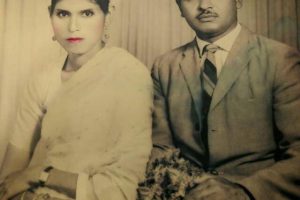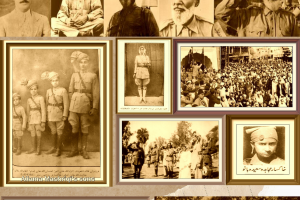By By M. H. Rahman
Some forces, without any regard to communal harmony and social peace, tried to justify the recent violence committed by Bodos against the poor Bengali-speaking Muslims living in Kokrajhar district of Assam, terming them as “illegal migrants”. The purpose of this writeup is to show that the defaming of the Bengali-speaking Muslims of Assam as “illegal migrants” from Bangladesh is unjustified and untenable.
Muslim settlement in the Brahmaputra Valley: The settlement of Muslims in the valley can be traced to as far back as the eighth century CE. Early Muslim settlers of Assam consisted of “Turks” who came to China from Turkistan, and of Arab traders, sailors, saints and travellers who visited Burma and the Gangetic valley of Bengal. The Turks had come to Assam through China crossing over the Himalayas and had settled in Darrang district of the state. (Brihattar Sylheter Itihas (History of Greater Sylhet) Volume I, edited by Md. Abdul Aziz et al, Brihattar Sylheter Itihas Pranayan Parishad, Sylhet, 1997).
In the eighth century, many Arab traders and sailors had settled in Arakan in Burma. They established matrimonial relationship with local people and their descendants, in course of time, became known as Rohingya Muslims. Some of these Muslims, later on, migrated to Bengal and different parts of North-East India (Farooque Ahmed, “Tracing early Muslim settlement in Manipur”, Muslim and Arab Perspectives, New Delhi, Vol. 4: 1-6 (1997).
In 1345, Ibn Battuta (d. 1377) met Ghiyasuddin, who was also known as Sheikh Jalaluddin of Tabriz, at Hajo, while on his way to China. He incorporated an account of the then Kamrup in his famous travelogue, Tuhfat al-Nuzzar fi ghara’ib al-Amsar wa ‘aja’ib al-asfar. In this account, he recorded that while he was returning from China, he saw people living in the Kamrup Mountains who resembled Turks and were capable of hard work.
The people of Muslimghopa near Mangaldoi claim till this day that they are descendants of the Turkish soldiers who entered Assam and settled in Darrang (Keramat Ali, “Oitihasik Prabazonar Ba’marlit Honkhalaghut Parinat Asomor Khilonziar Osthityar Honkat Uttaranar Upay Bichari,” Hidayat, Guwahati, January 2005).
In his work, Asomiya Bhasa Aru Sanskriti (p.115), B. K. Baruah has observed that Muslim saints, preachers and others came to Assam between eleventh and twelfth centuries CE.
It is obvious that much before the advent of Muhammad Ibn-Bakhtiyar Khilji, Muslims had settled in Assam and the native people had received the Islamic message of peace, equality, humanity, brotherhood and friendship with open arms. Native tribes like Koch, Mech and Tharus, embraced Islam towards the last part of the twelfth century CE. In his work, Tabaqat-e Nasiri, Maulana Minhajuddin recorded that the Koch and the Mech had developed so much liking for Islam that one of their chiefs converted to Islam in 1198 CE at the hands of Muhammad ibn Bakhtiyar Khilji (Maulana Minhajuddin, Tabakat-i-Nasiri, Reverty’s Translation, 1970, New Delhi; E. Gait, A History of Assam, 1967). Islam gave the converts a new identity and elevated them to a respected position, which they did not enjoy earlier in their society.
During 1204-1679, Muslim rulers and governors of Bengal sent as many as 19 military expeditions to Assam. During this period, thousands of Muslim soldiers, paiks and military officers settled down in different parts of Assam. Muslim saints and preachers also came to the area and spread over different places for preaching the message of Islam and delivering religious instruction to the new converts and early Muslim settlers. Many Muslim traders also visited Assam and settled down in various towns.
Political boundary of Assam: Until 1874, Assam meant the territory comprising of the area of the current districts of Nowgong, Kamrup, Sivasagar and Lakhimpur. William Robinson in his “A Descriptive Account of Assam” (Reprint, New Delhi, 1975, p.3) wrote that Ahom Kingdom comprised the area of the present day Assam excluding Goalpara, Surma Valley and the hill districts. It was centred in the Brahmaputra valley. The kingdom was about 500 miles in length with an average breadth of sixty miles.
In 1826, the British annexed Ahom kingdom to Bengal and created an administrative division called “Assam” under a commissioner and hill areas were added to it in phases. In 1874, Assam division was separated from Bengal and upgraded to a province under a Chief Commissioner. In this province, the British included not only the districts of Assam Commissionership but also Goalpara district of the erstwhile Cooch Behar Division as well as Cachar and Sylhet districts of Dacca Division (H. K. Barpujari (ed.), The Comprehensive History of Assam, vol. IV, Guwahati, 1992, pp. 28-31; A. K. Neogy, The Partitions of Bengal, Calcutta, 1984, pp. 36-49 cited in Imdad Hussain (ed.), The Guwahati Declaration and the Road to Peace in Assam, 2005, p. 19).
In fact, Goalpara was a part of the Bengal district of Rangpur at the time of taking over Bengal by the British. In 1818, three thanas of Rangpur, viz, Dhubri, Karaibari and Goalpara were separated from the district of Rangpur and made into a new division called “North-East Rangpur” under a Civil Commissioner to deal with the problem of law and order in the Garo frontier. Subsequently, it was managed by a Political Agent under the administrative control of the Commissioner of Cooch Behar, and was eventually transferred to Assam (J. B. Bhattacharjee, The Garos and the English, New Delhi, 1977, pp. 44-76 cited in Ibid, p. 20).
The province of Assam created in 1874 included areas which were ethnically and linguistically disparate, hardly one-fourth of the geographical area was Assamese-speaking and the Assamese population was less than one-third of the total population of this new province. Various tribal groups, Assamese and Bengalis, were indigenous in their respective areas. In fact, till the end of the British rule in 1948, Bengalis were outnumbered by the Assamese in the province of “Assam” (Census of India, 1931, Part I, (Assam) cited in Ibid, p. 20).
In 1905, Assam became a part of Eastern Bengal with the constitution of the new province of Eastern Bengal and Assam and had its secretariat at Dacca. In 1911, the partition of Bengal was annulled. But Surma valley and Goalpara remained with Assam. In July, 1947 Sylhet was transferred to East Pakistan.
Sylhet was transferred to East Pakistan because the Assamese leadership wanted to get rid of this Bengali-dominated region and desired to make Assam an Assamese-dominated state. But the arrival of 20 lakh Bengali Hindus as refugees into Assam during 1947-50 as a result of Partition became a hurdle in the realisation of this dream. Out of the 20 lakh of refugees, the Assam government gave shelter to some three lakh only. But when Bordoloi informed the Centre that Assam was not in a position to settle more refugees, Nehru wrote to him in May 1949 saying that Assam was getting a bad name for its “narrow” approach to the refugee problem (Udayon Misra, The Transformation of Assamese Identity: A Historical Survey, NEIHA, Shillong, 2001, p. 50). Around this time communal riots were engineered and several lakh Muslims were driven out of Assam.
As a result of the movement to make Assamese the official language and medium of instruction of the state, Assam lost Arunachal, Mizoram and Meghalaya regions. Now it is on the verge of losing some more parts in the form of Bodoland and Karbiland that have already been given the status of Autonomous District Council wherein the right of the non-tribal to purchase land and settle is restricted. In Upper Assam, there is anti-Bengali and anti-Bihari sentiment. In such a situation, both Hindu and Muslim Bengalis have no alternative but to settle predominately in the region of erstwhile Bengal that is Cachar, Hailakandi, Karimganj, Goalpara and Dhubri which were originally Bengali. Thus Assam is now unofficially divided into four clear regions: Upper Assam, Lower Assam (Goalpara and Dhubri), Barak Valley and hill regions dominated by people settled there.
Migration to Assam: It is difficult to say with certainty when and how Assam was populated due to lack of fool-proof historical evidence. However, if the physical type, language and history of the different races residing in Assam are studied, it appears that the state was populated by different peoples coming from different directions at different times. The forefathers of today’s races of the state had migrated from Myanmar (Burma), China, Japan, Thailand, Bihar, Bengal and Orissa. The study of history from a long-term perspective shows that Assam is, in fact, a land of migrants. The Ahom came to the state in the beginning of the second quarter of the 13th century CE, long after the arrival of Muslims in Assam.
As per the period of their migration, Muslims can be divided into three groups. The first stream of Muslims came to Assam during 800-1200 CE, the second stream came during 1200-1826 and the third stream of Muslims came to the state during 1826-1945. Most of the descendants of the Muslims who came to Assam prior to 1826 have already adopted Assamese as their mother tongue and became part of the Assamese society. They cannot be called “immigrants”. Here we shall concentrate our discussion on the migration of the last group of Muslims.
With the advent of the British rule, many Hindu and Muslim Bengalis came to Assam as servants of the British government. By 1826, the socio-economic situation of Assam deteriorated. Civil wars, Burmese invasions and natural calamities, like earthquake, kala-azar, malaria and dysentery, decimated the population. There was no surplus in agricultural production. Local people did not like to work hard and there was shortage of work force.
Taking this situation in view and to raise the revenue of the government, the British administration decided to develop tea industry and agriculture and to construct roads and railways for the improvement of communication required for expansion of trade and commerce. Since the workforce was in shortage in Assam, they decided to bring labourers and farmers from other parts of British India. The Assamese middle class supported this move. Anandaram Dhekial Phukan, Gunabhiram Barua and Babu Gunjanan Barua actively supported the government proposal and gave representations to the government to this effect. By the end of the 19th century, arrival of workforce from outside Assam began. The imported workforce consisted of tea garden labourers, Nepalis and Bengali farmers. Bengali farmers consisted of both Hindus and Muslims (See Sajal Nag’s Roots of Ethnic Conflict, 1990, for details).
In 1874, the Muslim population of Assam was 1,104,601 and its percentage to the total population was 28.8 percent (M. Kar, Muslims in Assam politics, 1997, p. 30). It increased to 3,441,554 in 1941 (Ibid, pp. 43f). The 1941 Muslim population of Assam was composed of the indigenous Muslims of the Brahmaputra Valley and erstwhile Bengal regions of Goalpara, Cachar as well as Sylhet which were incorporated in Assam province and the Muslim farmers who were brought to the province by the British government and Assamese landlords from East Bengal.
It is to be noted here that the migration of Bengali Hindus and Muslims to Assam during the British rule was totally legal. In 1931, Indian National Congress passed a resolution in Karachi which granted every citizen of India the right to move freely throughout India and stay and settle in any part thereof. In 1935, Government of India Act was passed. Section 298 of the Act stated: “No subject of His Majesty domiciled in India shall on grounds only of religion, place of birth, descent, colour or any of them be ineligible for office under the crown in India or be prohibited on any such grounds from acquiring, holding or disposing of property or carrying on any occupation, trade, business or profession in British India.” It is now clear that Muslims who came to Assam from Bengal prior to independence in 1947 and the indigenous Muslims of erstwhile parts of Bengal, like Goalpara and Barak Valley which became parts of India in 1947, cannot be labelled as “illegal migrants”, or “foreigners”, East Pakistani or Bangladeshis. It is highly incorrect and objectionable..
Mention may also be made here that a section of Assamese leaders overlooking the Karachi Resolution of 1931 and the section 298 of the Government of India Act 1935 sowed the seeds of parochialism, communalism and separatism in Assam on religious and lingual lines. This led to the transfer of Sylhet to East Pakistan, eviction of a large number of Muslims from Assam and eruption of communal riots in different places of the state on the eve of independence.
Expelling of Muslim from Assam as “foreigners”: Immediately after independence, expulsion of Muslims from Assam as “foreigners” and “undesirable elements” started and many were expelled from the state while the door of migration and settlement of Nepalese in all parts of India including Assam was kept open under the Indo-Nepal Treaty of 1950.
During the communal riots of 1948-1950, countless Muslim houses were burnt down, many Muslims were killed and five to six lakh Muslims were compelled to leave Assam for East Pakistan (Hem Barua, The Red River and the Blue Hills, p. 129 cited in Hidayat, June 2000 pp. 17f).
During the period 1952-1971, over two lakh Muslims were expelled from Assam as “East Pakistanis” and “undesirable elements”. After the creation of Bangladesh till 2002, at least one lakh Muslims were detected and deported as “Bangladeshis”, while the real foreigners were left untouched.
Thus, during the period 1952-2002, over 330,076 Muslims were expelled from the state (The Milli Gazette, 16-31 January 2005, p. 10). In fact, the entire issue of foreigners is based on communal lines.
Besides expelling, a large number of Muslims were murdered as “Bangladeshis” during the last 60 years. In Nellie alone, over two thousand Muslim men, women, children and infants were murdered during one night in February 1983.
“Bangladeshis”: During the war of Bangladesh liberation in 1971, a large number of East Pakistani refugees comprising of Hindus and Muslims entered Assam though the number of Muslim refugees was not very large. Though this population returned to their places of origin after the creation of Bangladesh, yet it is assumed that a chunk of this population stayed back in the state. So far as the question of Muslim refugees is concerned, it appears that almost all of them were sent back from the state.
Harassment of Assam Muslims: The total Muslim population of Assam was 83 lakh in 2001. Half of this population is daily wage-earners. They go to different places of the state to earn their livelihood and stay there temporarily till employment is available. But it has been observed that when the poor, indigenous Muslims of Goalpara, Dhubri, Barpeta, Nalbari, Cachar, Karimganj etc. go to Upper Assam in search of livelihood, they are harassed, ill-treated and persecuted by communal forces branding them as immigrants and Bangladeshis. Their fundamental right to earn their livelihood, move to and settle in any part of India is, thus, being continuously violated. This is one of the reasons of high concentration of Muslim population in some districts of Assam. The purpose of harassing these poor Muslims appears to be to compel them to leave Assam under duress.
Conclusion: Muslims of Assam have no objection to detection and deportation of foreigners. Rather, they demand that all foreigners irrespective of their caste, colour and religion must be detected and expelled from the country through due process of law. At the same time, it must be ensured that genuine citizens are not harassed and their legal and human rights are not violated in the process.
Muslims living permanently in Assam are as indigenous as the Assamese Hindus living in the state. The efforts to divide them on religious and cultural line will have to be checked effectively. The secular, peace-loving social and human rights activists should seek legal means for protection of legal and human rights of the poor Bengali Muslims on one hand and on the other, Muslim scholars, intellectuals and students should consider filing defamation cases against those who cause injury to their reputation by levelling them as illegal migrants and Bangladeshis.
This article appeared in The Milli Gazette print issue of 16-31 August 2012





7 Comments
Comments are closed.